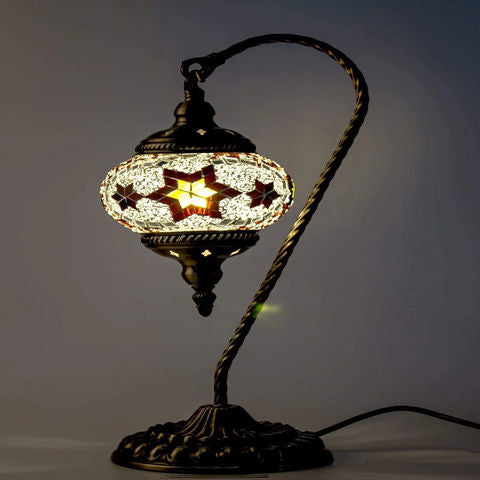The Impact of Mosaic Art on Architecture and Interior Design

Mosaic art is a unique form of art that has been used in architecture and interior design for centuries. From ancient monuments to modern-day homes, mosaic art was there to create stunning visual effects. But what is the true impact of mosaic art on architecture and interior design? In this article, we will explore the influence that mosaic art has had on the aesthetics of buildings and places all over the world.
You can reach our product by clicking the image above.
Introduction to Mosaic Art
Mosaics have had a long and storied history in architecture, dating back to antiquity. From the ancient Greeks and Romans to the Byzantine Empire and the Islamic world, mosaics have been used to decorate and embellish buildings, monuments, and other structures.
Mosaics are made from small pieces of glass, stone, or ceramic that are arranged in a pattern to form a picture. They can be used to create intricate designs and patterns, as well as to depict figurative scenes such as battle or religious scenes, and portraits.
The use of mosaics in architecture is often associated with religious structures, such as Gothic mosaic art on churches and mosques. This is because they were often used to decorate and embellish the walls and ceilings of such buildings. In addition, mosaics have also been used to create decorative elements in secular buildings, such as palaces and villas.
Mosaics can also be used to create an interesting and unique effect on the exterior of a building. This is especially true of Islamic architecture, where intricate patterns and designs are often found on the façades of buildings. Today, mosaics are still used to create decorative elements on the exterior and interior of buildings, as well as in public spaces.
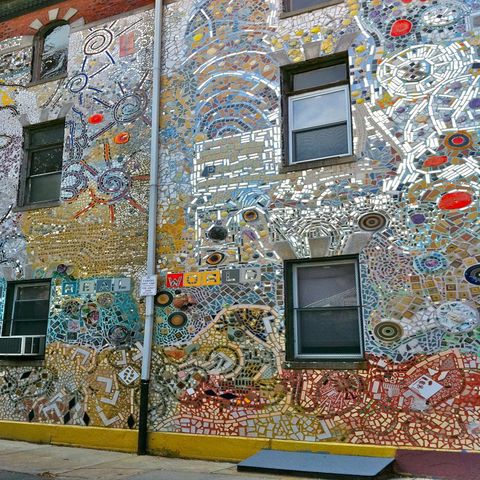
Mosaic Art and Architectural Design
Since the time of the ancient Greeks, Romans, and Byzantines, who first developed mosaic art, it has been widely spread over Medieval Western Europe and eventually made its way to the Islamic world and Eastern Europe.
Through the modern period, mosaic art was revived through the Arts and Crafts movement. This revival was furthered by modern architects and artists, such as Antoni Gaudi of Catalan Modernism, who brought mosaic art to a global level. Gaudi pays great attention to every detail of his designs and uses materials like ceramics, glass, mosaic patterns, marble tiles, and mosaic tiles to create his architectural masterpieces.
With the emergence of the Byzantine Empire, mosaic art rose to new heights in terms of creativity, perspective, and technique, becoming an essential part of Byzantine architecture. This drew a great number of Roman and Greek artisans and craftsmen to the Empire.
During this period, new smalti glasses were produced with large sheets of colored glass. The technique employed in this was to leave smalti tiles without grout, in order to produce a reflection of light within the glass.
In the early 6th century, Byzantine artisans developed a new technique for setting glass tiles. Following the Muslim invasion of the Eastern provinces of the Byzantine Empire, Islamic architecture was impacted by Byzantine architectural techniques.
In the 19th century, the Art Nouveau movement revived the interest in mosaic designs. This movement joined decorative arts with architecture and incorporated mosaic art, thanks to the efforts of Antoni Gaudi and Joseph Maria Jujol, who both imagined the grandiose scenario of Parc Güell. Their mosaic technique was known as the trencadis technique, in which tiles covered the surfaces of buildings.
Nowadays, Art Nouveau is considered to be a modernist reinterpretation of Neoclassicism. A lot of Art Nouveau monuments have been included in the UNESCO World Heritage List, contributing to the countries’ cultural heritage.
As we enter the 21st century, mosaic art continues to be in the spotlight. The medium is still evolving, with new ideas being created every day. The British Association for Modern Mosaics and The Society of American Mosaic Artists have been founded to uphold mosaic artworks and their applications in architecture and beyond!
Artists have been captivated by the alluring and often unpredictable range of materials that go into crafting an expressive mosaic, or "Vehicle of Expression". Innovative contemporary artists are giving this classic medium a revitalized contemporary treatment to take their artwork to the next level. We strongly believe that in the late 21st century, a unique generation of mosaic artists on a scope previously unseen in human history will be emerging. Mosaics will become the link for communication between modern-day audiences and modern-day horizons.
![]()
Examples of Iconic Mosaic Art in Architecture
Mosaic art in architecture has been a powerful means of visual storytelling since antiquity, adding both grandeur and detail to buildings worldwide. Some iconic examples of this art form span different eras and cultures, showcasing the versatility and timeless beauty of mosaic work. Let's take a closer look at these unique examples.
1) St George's Church, Topola, Serbia
The mosaics of St George's Church are some of the most beautiful and intricate examples of Byzantine art in the world. Dating back to 1208, the mosaics depict religious and historical scenes, as well as portraits of rulers and important figures from the time.
The mosaics are made of small pieces of glass, stone, and colored marble, and each piece has been placed with precision to create a larger picture. The larger panels depict stories from the Old and New Testaments, such as the birth of Jesus and the Crucifixion.
Other panels feature portraits of the rulers of Serbia, including King Stefan Nemanja, who commissioned the mosaics. Despite the passage of time, the mosaics of St George's Church remain in excellent condition.
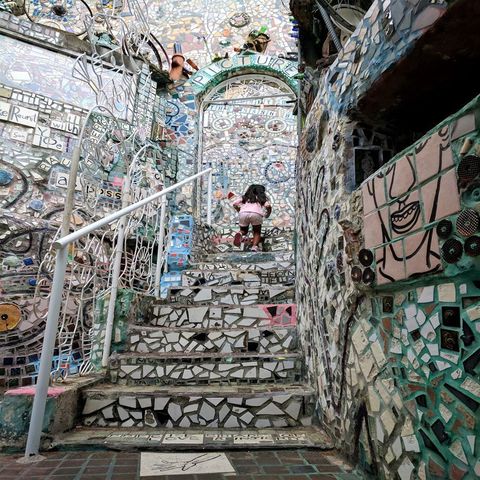
2) Philadelphia's Magic Gardens, Pennsylvania, USA
Philadelphia's Magic Gardens is a stunning outdoor art installation located in the heart of the city. Featuring a maze of pathways lined with vibrant mosaics and sculptures, it's a unique and captivating destination for visitors.
The gardens were created by visionary artist Isaiah Zagar, who spent more than a decade constructing the site from found and recycled objects. The main attraction is the mesmerizing mosaic walls, which are made up of thousands of pieces of colored glass, tiles, and mirrors.
The artwork is complex and intricate, and no two pieces are alike. Other highlights include a variety of sculptures, ranging from abstract figures to more representational works.
3) Madaba Map, Jordan
The Mosaic of Madaba Map is an impressive art piece located in the Church of St. George in Madaba, Jordan. It is a large floor mosaic that was made in the 6th century AD and is considered to be one of the oldest surviving maps of the Holy Land.
The gorgeous mosaic presents a detailed depiction of the region from Lebanon in the north to the Nile Delta in the south and from the Mediterranean Sea in the west to the eastern deserts of the Arabian Peninsula. It pops with two million pieces of brightly-colored stone and features the names of over 160 locations.
You'll find some of the most influential ancient cities, like Jerusalem, Jericho, and Bethlehem, as well as the Dead Sea, the Red Sea, and the Jordan River on the map. This is an invaluable resource if you're curious about the locus of early Christian communities in the area.
4) Sheikh Zayed Grand Mosque, Abu Dhabi, UAE
The Sheikh Zayed Grand Mosque is renowned for its spectacular mosaics. These intricate works of art adorn the walls, columns, and domes of the mosque, making it one of the most impressive Islamic buildings in the world.
The mosaics feature intricate geometric shapes and floral patterns, as well as verses from the Quran. They are made from marble, glass, and semi-precious stones, which come in a variety of colors and textures.
There are over 7,000 square meters of mosaic in the mosque, making it one of the largest collections of Islamic art in the world. The mosaics were designed by Emirati artist, Hussain Ali, and it took over four years to complete the project.
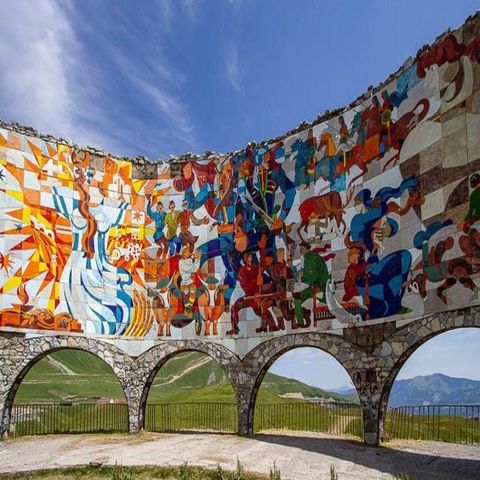
5) Russia–Georgia Friendship Monument, Gudauri, Georgia
The Mosaics of Russia–Georgia Friendship Monument is a unique monument that celebrates the long-lasting friendship between Russia and Georgia. The monument, designed by local artists, features two large mosaics depicting the two countries in a heart-shaped border.
The monument was built in 1983, depicting scenes from Russian and Georgian history. It is located in a prominent spot in Gudauri which sits backed by stunning snow-capped mountains and you can see it from far away.
6) Parc Güell, Barcelona, Spain
Parc Güell, situated atop dazzling Carmel Hill and offering breathtaking views of Barcelona, is a wondrous gift from the genius Catalan architect, Antoni Gaudi. The park is truly a marvel, boasting mesmerizing walls, whimsical benches, and mythical creatures, all adorned with brilliant mosaics.
Parc Güell, the world's most enchanting public park, is a UNESCO-listed treasure and is immensely popular.
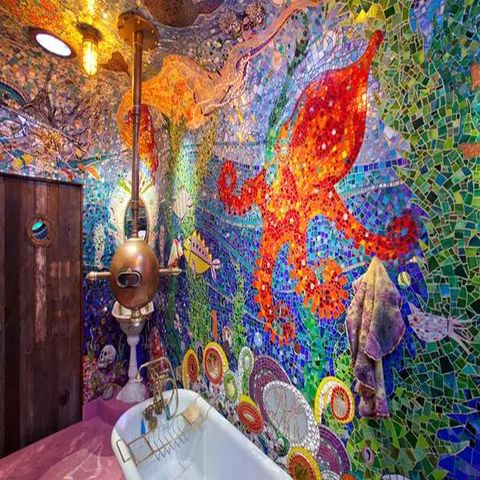
Mosaic Art and Interior Design
Mosaic art is a truly remarkable form of art that is not only aesthetically pleasing but also tells a captivating story and preserves its elements piece by piece. With some creative thinking and a few changes, any area can be transformed into a magnificent display of elegance.
In the world of modern and minimal interior design, it can be difficult to envision how a designer can seamlessly incorporate a traditional art form into a contemporary home. However, the secret is out: mosaic art can be whatever you want it to be!
Adding monochrome home decor ideas to your place can give it a vibrant, special look. Mosaics are a great way to liven up any interior design, even the most boring ones. You can find a variety of colors and designs, both modern and classic, suitable for all kinds of spaces, large or small.
Modern Mosaic Design Ideas for Interior Spaces
Making custom mosaics to add to your space is a great way to add your own unique flair, and it can be a very enjoyable process as you come up with creative ideas. It is an absolute must to greatly boost the appeal and value of your space.
1) Mosaic Wall Art
Selecting a mosaic wall art piece, either glass or marble, for your interior is like selecting any painting to add beauty to your walls. It is important to carefully consider which complementary mosaic mural, color, and design best suits your room.
You also have the options of painting, mosaic wallpaper, tile inserts, and much more. Analyze the purpose of the room, and the current furnishings and try to incorporate the colors and textures of the existing style.

2) Mosaic Backsplash
Transform your kitchen into a stunning showroom with a beautiful mosaic backsplash! If you want to add a stylish touch that is both functional and visually appealing, you can install it above the sink or stovetop.
If you have a neutral kitchen design and color palette, a mosaic backsplash that creates a dynamic contrast would be a perfect choice. Alternatively, if you have a vibrant kitchen theme, you could use a mosaic backsplash that ties in with the existing decor.
3) Mosaic Flooring
Mosaic artwork is not just limited to walls; it can also create awe-inspiring centerpieces as mosaic flooring. When selecting a mosaic rug, it is important to ensure it is compatible with the colors, style, and design of the room, just as one would when selecting any other type of rug or floor tiling.
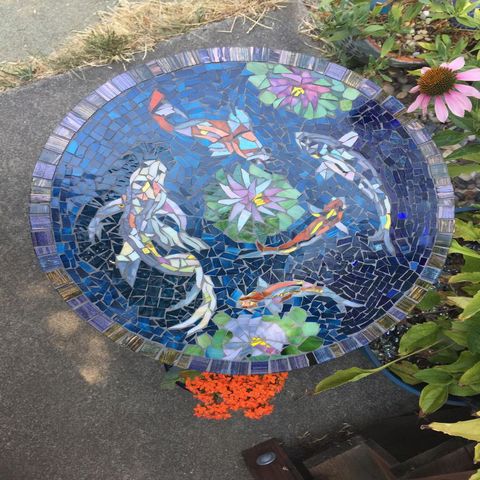
4) Mosaic Table Tops
A coffee table can really make a statement in a room, providing a beautiful centerpiece. With the endless variety of mosaic designs available to use on the top, an abstract floral pattern would create a stunning addition to any room with its warm colors.
5) Mosaic Mirrors
The incredible power of a well-placed mirror cannot be overstated. You know you've stepped into a special place when a mirror captures your attention, and it doesn't have to cost a fortune. A beautiful piece like a smoky glass oval framed with a mosaic border is a great way to start. Pick colors that enhance the existing decor and watch the room come alive!
6) Modern Mosaic Designs
Modern mosaic tiles are perfect for adding a pop of color and vibrancy to bathrooms and kitchen backsplashes. They're great for creating unique decorating accents and bringing a touch of modern style to your interior design.
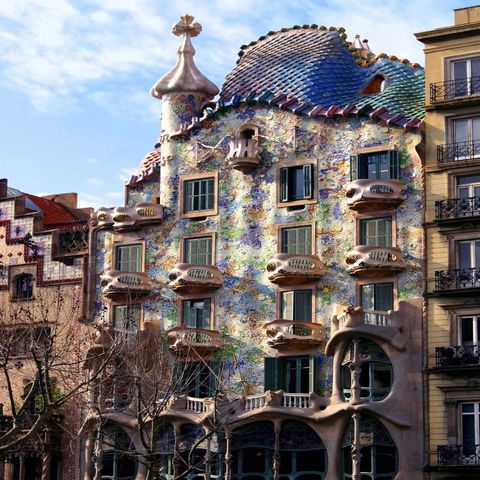
The Future of Mosaic Art in Architecture and Interior Design
Today's creative artists never seem to run out of ideas for their mosaic designs, and they always have plenty of materials to use. From Elvis crafted out of beer and soda cans, to the portrait of Rosie O'Donnell built with junk food, modern mosaic makers are innovating the art form every day.
It's a real head-scratcher for most of us to understand how they come up with these ideas, although some are pretty self-explanatory - like Kevin Bacon made from bacon, or Darth Vader made from recycled electronics. Buttons, pins, coins, corks, and even cupcakes can be turned into art if you have the skill and talent!
It's amazing to see how mosaic art stands out in today's modern art scene. No matter how strange and twisted art expositions seem to be, mosaic art consistently captures the beauty and admiration of all who see it. Whether it's composed of butterfly wings or candy sprinkles, mosaic art is sure to awe and inspire. Visiting the Metropolitan Museum is a great way to get a glimpse of the future of all art, including mosaics.
You can reach our previous article from https://www.artmasterclass.com.au/blogs/news/how-to-clean-and-maintain-your-mosaic-lamp






